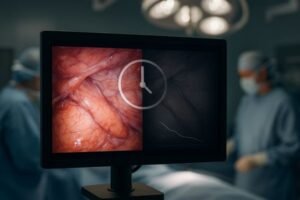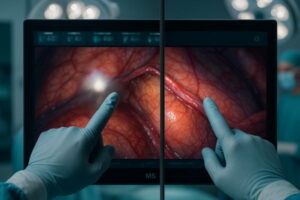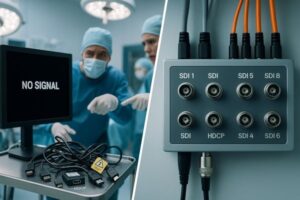Relying on yesterday’s display technology limits today’s advanced medical imaging. This stagnation hinders diagnostic potential and prevents clinicians from seeing what is truly possible with modern equipment.
Innovation in the medical display industry is driven by the convergence of several key forces. These include advancements in core display technologies, the integration of artificial intelligence, new materials, specific market demands, and cross-industry collaborations.
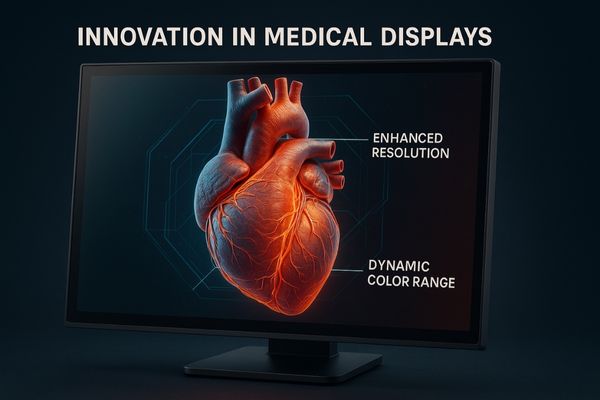
The medical display is the final, critical window into the patient. For decades, its evolution has been steady, but today we stand at an inflection point. The forces reshaping medicine, from AI-powered diagnostics1 to minimally invasive surgery2, are placing unprecedented demands on visualization technology. Innovation is no longer a linear path of simply adding more pixels. It is a complex interplay of different fields. Understanding these sources of innovation is crucial for any healthcare institution looking to invest in technology that will not only meet today’s standards but also anticipate the challenges of tomorrow. This article explores the key drivers that are shaping the next generation of medical displays.
Technological Drivers Shaping Medical Displays
Using outdated monitors with modern imaging scanners creates a critical bottleneck. This mismatch means valuable diagnostic data captured by the scanner is lost before it ever reaches the clinician’s eyes.
Core technological drivers for medical displays include advancements in panel resolution, backlight technologies like Mini-LED, and sophisticated calibration software. These elements work together to improve image detail, brightness, uniformity, and color accuracy.
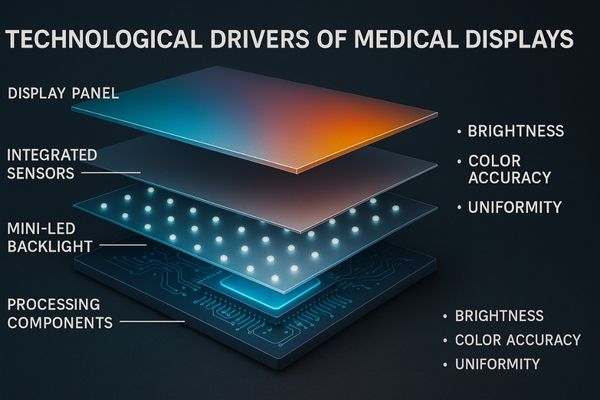
I believe that true innovation in medical displays is rarely the result of one single breakthrough. Instead, it is the combined evolution of multiple core technologies. The display panel itself is just one piece of the puzzle. The most visible driver is resolution, with the industry moving from 2MP and 3MP standards toward 8MP, 12MP, and even higher for specialized fields. However, what illuminates those pixels is just as important. The shift from traditional CCFL backlights to LED, and now to emerging technologies like Mini-LED3, allows for far greater control over brightness and contrast, improving uniformity across the screen and enabling deeper black levels. Software and internal processing are the brains of the operation. Modern displays have sophisticated internal processors and sensors that provide automated DICOM calibration4, stability control, and uniformity correction. This ensures the display performs consistently over its lifespan. The MD26GA – 2MP Diagnostic Monitor exemplifies this integration, combining a high-quality panel with robust electronics to deliver reliable performance for general radiology and clinical review.
| Technology Driver | Impact on Performance | Clinical Application |
|---|---|---|
| Higher Resolution (4K, 8K+) | Increased detail for small structures | Radiology, Pathology, Surgical Microscopy |
| Mini-LED Backlighting | Higher contrast, better uniformity | Mammography, Surgical Displays |
| Integrated Sensors | Automated DICOM calibration, stability | All diagnostic and surgical displays |
| Advanced Processors | Faster image rendering, multi-input | Multi-modality fusion, PACS workstations |
Impact of AI and Image Processing Innovations
AI algorithms can detect subtle patterns humans might miss, but this is useless if the display cannot render them. An inadequate monitor makes AI-generated insights invisible, negating the investment in advanced software.
The rise of AI in medical imaging is compelling displays to evolve. They now require higher dynamic range, superior grayscale precision, and real-time processing to accurately visualize the subtle findings highlighted by diagnostic algorithms.
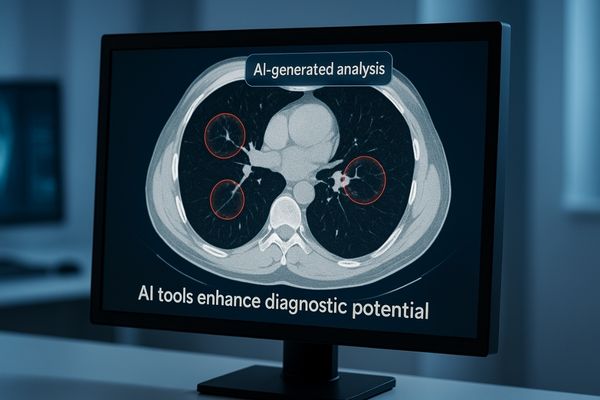
The integration of Artificial Intelligence5 into medical imaging workflows is one of the most powerful forces driving innovation today. I have seen how AI is shifting from a research concept to a practical tool in the reading room. These algorithms can sift through vast datasets, like a 3D tomosynthesis study, and flag minute areas of potential concern. This creates a new requirement for the display. It must not only present the base image with perfect clarity but also flawlessly render the AI overlays and annotations. This demands exceptional grayscale precision to ensure that a faint lesion flagged by AI is actually visible to the human eye. Furthermore, as AI tools become more interactive, displays need faster processing capabilities to handle real-time adjustments without lag. The future I envision is one where the display and the AI work as a single, cohesive system. A display like the MD120C – 12MP High-Precision Diagnostic Monitor with AI Calibration is designed for this future, offering the immense resolution and intelligent calibration needed to serve as the perfect canvas for AI-assisted diagnostics
Emerging Materials and Manufacturing Techniques
Traditional display materials have limitations in brightness, lifespan, and energy consumption. Continuing to use them puts a cap on performance and increases the total cost of ownership for hospitals.
New materials like Mini-LED and OLED, along with advanced manufacturing processes, are unlocking new levels of performance. They promise higher contrast ratios, improved energy efficiency, and thinner, more durable display designs.
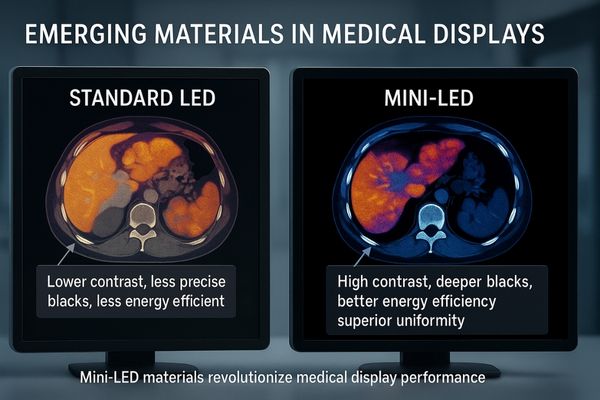
The physical materials used to build a display are a fundamental source of innovation. For years, LCD with LED backlighting has been the dominant technology. However, we are now seeing the introduction of new materials that promise to overcome its inherent limitations. Mini-LED technology6, for example, uses thousands of tiny LEDs in the backlight instead of a few dozen. This creates hundreds or even thousands of local dimming zones, allowing for dramatically higher contrast ratios and deeper blacks that approach the performance of OLED. OLED (Organic Light-Emitting Diode) technology7 is another key innovation, where each pixel generates its own light. This allows for perfect black levels and incredibly thin form factors. While OLED currently faces challenges with lifespan and peak brightness in the demanding medical field, its potential is undeniable. These new materials also impact energy efficiency and thermal management, which are important considerations in any clinical setting. Our MS321PB – 32" 4K Surgical Monitor, for instance, benefits from the latest panel and lighting technologies to deliver brilliant, stable images while managing heat effectively in a sterile operating room environment.
Market Demands Fueling Product Differentiation
A one-size-fits-all display fails to meet the unique needs of different clinical departments. This forces compromises, leading to inefficient workflows in specialized areas like surgery, endoscopy, or radiology.
Specific demands from diverse clinical markets are driving the creation of highly specialized displays. This product differentiation results in unique form factors, such as dual-screen monitors on a single panel, and features tailored for surgery, mammography, or pathology.
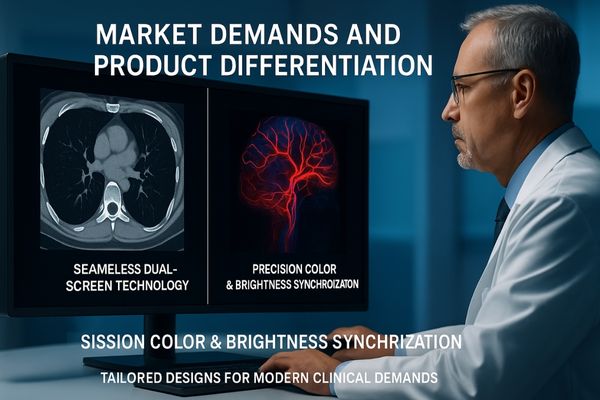
I have always believed that listening to clinicians is the most direct path to meaningful innovation. The needs of a radiologist are very different from those of a surgeon or a pathologist. This diverse market demand is a powerful engine for product differentiation. For example, radiologists often work with two side-by-side monitors to compare current and prior studies. This led to the innovation of dual-screen monitors8 built on a single, seamless panel, which eliminates the distracting bezel between screens and ensures perfect color and brightness matching. Surgical environments demand high brightness, anti-glare surfaces, and robust, sealed designs that can be easily disinfected. Endoscopy requires extremely accurate color reproduction to assess tissue health. As a result, we see the market moving away from general-purpose medical displays and toward purpose-built solutions9. This specialization ensures that the tool is perfectly matched to the task, improving both efficiency and diagnostic confidence. The MD46C – Dual-screen Diagnostic Monitor (Single Panel) is a direct response to a specific market need, streamlining the reading workflow for radiologists.
| Clinical Department | Key Display Requirement | Example Feature |
|---|---|---|
| Radiology | Grayscale accuracy, comparison viewing | DICOM Part 14 calibration, bezel-free dual screens |
| Surgery | High brightness, durability, wide viewing angles | Sealed IP-rated front, anti-glare coating |
| Endoscopy | Precise color reproduction | Wide color gamut, multiple gamma curves |
| Pathology | Ultra-high resolution, color accuracy | 4K/8K resolution, sRGB color space |
Collaborations and Ecosystem Development in the Industry
A display manufacturer working in isolation cannot solve complex clinical challenges. This siloed approach results in products that fail to integrate smoothly with the broader ecosystem of medical technology.
Meaningful innovation increasingly comes from collaborations between display manufacturers, imaging equipment companies, AI software firms, and clinical end-users. This ecosystem approach ensures that new products are integrated, validated, and clinically relevant.
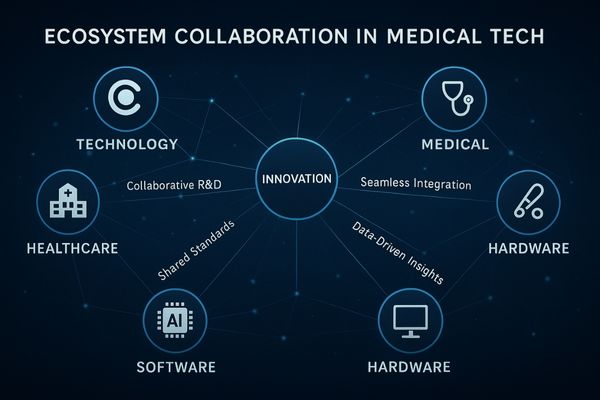
In my experience, the most impactful innovations arise from collaboration. A medical display10 does not exist in a vacuum. It is part of a complex imaging chain that includes scanners, cameras, archives (PACS), and software. True progress happens when experts from these different domains work together to solve a clinical problem. For example, developing a next-generation endoscopic display11 requires a deep partnership with endoscopic camera manufacturers to ensure the monitor can perfectly translate the camera’s sensor data into a visually accurate image. Integrating a new AI tool requires collaboration with the software developer to optimize how results are presented to the clinician. These partnerships create a powerful ecosystem where each component is designed to work in harmony with the others. It ensures that the final product is not just a collection of impressive specifications but a validated, integrated solution that works seamlessly in the real world. Our MS247SA – 24" FHD Endoscopic Monitor is a product of such collaboration, tuned to meet the specific color and latency requirements of modern endoscopic systems.
Conclusion
The future of medical displays is being shaped by converging innovations. Technological progress, AI integration, new materials, specialized market needs, and industry-wide collaboration all drive the development of better diagnostic tools. To stay ahead with cutting-edge medical display solutions, contact Reshin at martin@reshinmonitors.com.
-
Exploring this link will provide insights into how AI is transforming diagnostics, enhancing patient care and outcomes. ↩
-
This resource will explain the benefits of minimally invasive techniques, crucial for modern surgical practices. ↩
-
Explore how Mini-LED technology enhances medical displays with better brightness and contrast, crucial for accurate diagnostics. ↩
-
Learn about DICOM calibration’s role in ensuring display accuracy and consistency, vital for medical imaging. ↩
-
Explore this link to understand how AI is revolutionizing medical imaging, enhancing diagnostics and patient care. ↩
-
Explore the benefits of Mini-LED technology, which enhances contrast and energy efficiency in modern displays. ↩
-
Learn how OLED technology offers superior black levels and thin designs, revolutionizing display performance. ↩
-
Explore how dual-screen monitors enhance radiology workflows and improve diagnostic accuracy. ↩
-
Learn about the advantages of purpose-built solutions in healthcare and their impact on patient care. ↩
-
Explore this link to understand how medical displays are evolving and their impact on healthcare. ↩
-
Discover the significance of endoscopic displays in enhancing visualization during surgeries. ↩

